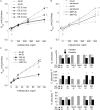Maternal diesel inhalation increases airway hyperreactivity in ozone-exposed offspring
- PMID: 22052876
- PMCID: PMC3359947
- DOI: 10.1165/rcmb.2011-0256OC
Maternal diesel inhalation increases airway hyperreactivity in ozone-exposed offspring
Retraction in
-
Retraction: Maternal diesel inhalation increases airway hyperreactivity in ozone-exposed offspring.Am J Respir Cell Mol Biol. 2015 Apr;52(4):523. doi: 10.1165/rcmb.524retraction. Am J Respir Cell Mol Biol. 2015. PMID: 25830632 Free PMC article. No abstract available.
Abstract
Air pollutant exposure is linked with childhood asthma incidence and exacerbations, and maternal exposure to airborne pollutants during pregnancy increases airway hyperreactivity (AHR) in offspring. To determine if exposure to diesel exhaust (DE) during pregnancy worsened postnatal ozone-induced AHR, timed pregnant C57BL/6 mice were exposed to DE (0.5 or 2.0 mg/m(3)) 4 hours daily from Gestation Day 9-17, or received twice-weekly oropharyngeal aspirations of the collected DE particles (DEPs). Placentas and fetal lungs were harvested on Gestation Day 18 for cytokine analysis. In other litters, pups born to dams exposed to air or DE, or to dams treated with aspirated diesel particles, were exposed to filtered air or 1 ppm ozone beginning the day after birth, for 3 hours per day, 3 days per week for 4 weeks. Additional pups were monitored after a 4-week recovery period. Diesel inhalation or aspiration during pregnancy increased levels of placental and fetal lung cytokines. There were no significant effects on airway leukocytes, but prenatal diesel augmented ozone-induced elevations of bronchoalveolar lavage cytokines at 4 weeks. Mice born to the high-concentration diesel-exposed dams had worse ozone-induced AHR, which persisted in the 4-week recovery animals. Prenatal diesel exposure combined with postnatal ozone exposure also worsened secondary alveolar crest development. We conclude that maternal inhalation of DE in pregnancy provokes a fetal inflammatory response that, combined with postnatal ozone exposure, impairs alveolar development, and causes a more severe and long-lasting AHR to ozone exposure.
Figures





Comment in
-
Findings of Research Misconduct.Fed Regist. 2019 Nov 7;84(216):60097-60098. Fed Regist. 2019. PMID: 37547121 Free PMC article. No abstract available.
Similar articles
-
A mouse model links asthma susceptibility to prenatal exposure to diesel exhaust.J Allergy Clin Immunol. 2014 Jul;134(1):63-72. doi: 10.1016/j.jaci.2013.10.047. Epub 2013 Dec 22. J Allergy Clin Immunol. 2014. PMID: 24365139 Free PMC article.
-
Maternal exposure to particulate matter increases postnatal ozone-induced airway hyperreactivity in juvenile mice.Am J Respir Crit Care Med. 2009 Dec 15;180(12):1218-26. doi: 10.1164/rccm.200901-0116OC. Epub 2009 Sep 17. Am J Respir Crit Care Med. 2009. Retraction in: Am J Respir Crit Care Med. 2016 Mar 1;193(5):582. doi: 10.1164/rccm.1934retraction. PMID: 19762564 Free PMC article. Retracted.
-
Effects of concentrated ambient particles and diesel engine exhaust on allergic airway disease in Brown Norway rats.Res Rep Health Eff Inst. 2009 Nov;(145):5-55. Res Rep Health Eff Inst. 2009. PMID: 20198910
-
Maternal exposure to combustion generated PM inhibits pulmonary Th1 maturation and concomitantly enhances postnatal asthma development in offspring.Part Fibre Toxicol. 2013 Jul 16;10:29. doi: 10.1186/1743-8977-10-29. Part Fibre Toxicol. 2013. PMID: 23856009 Free PMC article.
-
Diesel exhaust particles and airway inflammation.Curr Opin Pulm Med. 2012 Mar;18(2):144-50. doi: 10.1097/MCP.0b013e32834f0e2a. Curr Opin Pulm Med. 2012. PMID: 22234273 Review.
Cited by
-
Maternal exposure to diluted diesel engine exhaust alters placental function and induces intergenerational effects in rabbits.Part Fibre Toxicol. 2016 Jul 26;13(1):39. doi: 10.1186/s12989-016-0151-7. Part Fibre Toxicol. 2016. PMID: 27460165 Free PMC article.
-
In utero and early life exposure to diesel exhaust air pollution increases adult susceptibility to heart failure in mice.Part Fibre Toxicol. 2013 Nov 26;10(1):59. doi: 10.1186/1743-8977-10-59. Part Fibre Toxicol. 2013. PMID: 24279743 Free PMC article.
-
In utero exposure to diesel exhaust air pollution promotes adverse intrauterine conditions, resulting in weight gain, altered blood pressure, and increased susceptibility to heart failure in adult mice.PLoS One. 2014 Feb 12;9(2):e88582. doi: 10.1371/journal.pone.0088582. eCollection 2014. PLoS One. 2014. PMID: 24533117 Free PMC article.
-
A mouse model links asthma susceptibility to prenatal exposure to diesel exhaust.J Allergy Clin Immunol. 2014 Jul;134(1):63-72. doi: 10.1016/j.jaci.2013.10.047. Epub 2013 Dec 22. J Allergy Clin Immunol. 2014. PMID: 24365139 Free PMC article.
-
Prenatal Exposure to and Cardiac Vagal Tone during Infancy: Findings from a Multiethnic Birth Cohort.Environ Health Perspect. 2019 Oct;127(10):107007. doi: 10.1289/EHP4434. Epub 2019 Oct 30. Environ Health Perspect. 2019. PMID: 31663780 Free PMC article.
References
-
- Hertz-Picciotto I, Park HY, Dostal M, Kocan A, Trnovec T, Sram R. Prenatal exposures to persistent and non-persistent organic compounds and effects on immune system development. Basic Clin Pharmacol Toxicol 2008;102:146–154 - PubMed
-
- Margolis HG, Mann JK, Lurmann FW, Mortimer KM, Balmes JR, Hammond SK, Tager IB. Altered pulmonary function in children with asthma associated with highway traffic near residence. Int J Environ Health Res 2009;19:139–155 - PubMed
-
- Fedulov AV, Kobzik L. Immunotoxicologic analysis of maternal transmission of asthma risk. J Immunotoxicol 2008;5:445–452 - PubMed
Publication types
MeSH terms
Substances
Grants and funding
LinkOut - more resources
Full Text Sources
Medical

